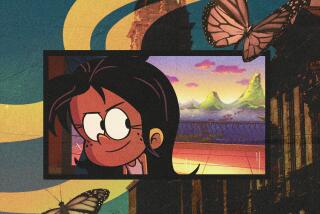‘Bold Caballeros y Noble Bandidas’ at the Autry National Center of the America West
A framed poster of Leo Carrillo starring as Mexican caballero Francisco “Pancho” Villa in the 1950 film “Pancho Villa Returns” rests, in all its pristine splendor, on a cobalt wall. Tag lines such as “The man who made history with cyclonic fury!” and “The Robin Hood of Mexico” are splashed across the bill, luring potential viewers to witness Villa as a paragon of virtue. But this is not a theater revisiting the golden age of Mexican cinema. The poster is part of the exhibition “Bold Caballeros y Noble Bandidas” at the Autry National Center of the America West.
FOR THE RECORD:
Autry museum: An article in Sunday’s Calendar section about the exhibition “Bold Caballeros y Noble Bandidas” at the Autry National Center of the American West gave an incorrect phone number for the museum. The correct number is (323) 667-2000. —
The show, on view through May 10 and co-presented by Arizona State University’s Hispanic Research Center, explores relations between the U.S. and its neighbor to the south after the Mexican Revolution of 1910 and the evolution of Mexican pop culture that resulted.
“The Mexican Revolution really created a cast of social heroes,” said Jonathan Spaulding, the museum’s chief curator. “This exhibit takes that idea and examines how these bandit heroes made their way into pop culture and the public’s consciousness, both in the past and even today.” The legends surrounding towering figures such as Emiliano Zapata, Joaquin Murrieta(sometimes called “the Mexican Robin Hood”) and Villa are palpable throughout the maze-like space. They and other caballeros became symbols of resistance to the U.S. occupation of lands that once belonged to Mexico. And their mystique inspired a robust anthology of film, art, folklore, music and literature that still shapes the identity of the borderlands.
“Most people’s understanding of the West is pretty limited,” Spaulding said. “It’s not all John Wayne movies.”
Walls burst with film posters, artwork, costumes, comic books and children’s toys -- whether from films based on actual bandits such as 1957’s “El Secreto de Pancho Villa,” a 1950 wooden hobbyhorse based on fictitious hero the Cisco Kid or the 1999 serigraph“Tierra-O Muerte,” in which Edward Gonzales illustrates the land struggles of the American Southwest by showing a rifle-toting Zapata outside the village of Tierra Amarilla, N.M. Music inspired by the folk heroes, such as War’s 1972 song “The Cisco Kid” (“Cisco Kid was a friend of mine / He drank whiskey / Pancho’d drink the wine”), serves as a soundtrack.
Although the show focuses on testosterone-fueled caballeros, it also delves into a shift in female cultural norms, making the case that the revolution served as a catalyst in the emancipation of subservient Mexican women, said Gary D. Keller, director of the Hispanic Research Center and co-curator of the exhibit. Women took on new roles as colonels, outlaws and revolutionaries, even on the big screen. After the revolution’s end in 1920, heroines often complemented the heroic male outlaws with aggressive roles, such as those of siren María Félix and Barbara Britton, famous for her role as the fictional Bandit Queen.
Inside the exhibition space, a montage of black-and-white snippets from films starring Félix plays on a loop, with Spanish subtitles. Félix, considered the Marilyn Monroe in the golden era of Mexican cinema, often used her smoldering sexuality to offset machismo. But the vigor of Félix and her femme fatale contemporaries wasn’t confined to the screen; they also inspired artwork for decades to come.
Hector Silva’s “María Félix With Rifle” (2002) shows Félix with a rebozo draped over her head and clutching a rifle against her chest. Her right eyebrow, perfectly shaped, is arched; her lips meet to form a slight grin. And in the 1991 serigraph “Adelita,” George Yepes depicts an ivory-skinned woman, hands crossed, gripping pistols pointing upward. Her delicate facial features offset her masculine physique.
With the lasting effect of the myths surrounding these symbols of the revolution, it’s no surprise that the exhibition blends the theme with the Day of the Dead to signify the deceased and living commingling.
Eduardo Oropeza’s silk-screen print “Héchale,” for example, depicts mustachioed skeletons in a mariachi band, each wearing a stylized, colorful sombrero. In José Guadalupe Posada’s “Female Calavera With Hat,” a female skeleton grins brashly beneath a plumed hat.
“It would be hard to do a show like this, and give it justice, without blending it with the Day of the Dead,” Keller said. “The folklore surrounding the outlaws lives on.”
Villarreal is a Times staff writer.
More to Read
The biggest entertainment stories
Get our big stories about Hollywood, film, television, music, arts, culture and more right in your inbox as soon as they publish.
You may occasionally receive promotional content from the Los Angeles Times.







